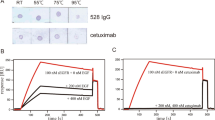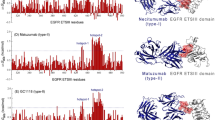Abstract
Anti-ErbB2 antibodies are well researched for the therapy of ErbB2-overexpressing tumors. The therapeutic potential and efficacy of these antibodies are closely related to their affinities to ErbB2. Previously we reported that an anti-ErbB2 antibody A21 targeting a conformational epitope comprising several loops in ErbB2 extracellular subdomain I and II could inhibit the proliferation of ErbB2-overexpressing cancer cells in vitro and in vivo. Here we found that another structureless and non-conserved loop in subdomain I of ErbB2 extracellular domain (ECD) was important for binding to A21, and then the antigen-contact sites on A21 were determined by site-directed mutation. The loop was constructed by molecular modeling, and a new model of A21-ErbB2 complex was generated by docking using the crystal structure of the scfv A21 and the model of ErbB2 ECD with the loop built. Based on the complex model, computational design for A21 affinity improvement was performed to enhance its affinity to ErbB2. Two mutants with about 1.7-fold improvement in affinity were obtained. Our study provided a rational molecular basis for affinity improvement and mechanism investigation of A21.




Similar content being viewed by others
References
Akiyama R, Sudo C, Ogawra H, Toyoshima K, Yamamoto T (1986) The product of the human C-erbB-2 gene a 185 kilodalton glycoprefein with tyrosine kinase activity. Science 232:1644
Bargmann CI, Hung MC, Wwinberg RA (1986) The neu oncogene encodea an epidermal growth factor recepter-related protein. Nature 319:226
Carlsson J, Nordgren H, Sjostrom J, Wester K, Villman K, Bengtsson NO, Ostenstad B, Lundqvist H, Blomqvist C (2004) HER2 expression in breast cancer primary tumours and corresponding metastases. Original data and literature review. Br J Cancer 90(12):2344–2348
Citri A, Skaria KB, Yarden Y (2003) The deaf and the dumb: the biology of ErbB-2 and ErbB-3. Exp Cell Res 284:54–65
Slamon DJ, Clark GM, Wong SG, Levin WJ, Ullrich A, McGuire WL (1987) Human breast cancer: correlation of relapse and survival with amplification of the HER-2/neu oncogene. Science 235:177–182
Graus-Porta D, Beerli RR, Daly JM, Hynes NE (1997) ErbB-2, the preferred heterodimerization partner of all ErbB receptors, is a mediator of lateral signaling. EMBO J 16(7):1647–1655
Harari D, Yarden Y (2000) Molecular mechanisms underlying ErbB2/HER2 action in breast cancer. Oncogene 19(53):6102–6114
Cho HS, Mason K, Ramyar KX, Stanley AM, Gabelli SB, Denney DW Jr, Leahy DJ (2003) Structure of the extracellular region of HER2 alone and in complex with the Herceptin Fab. Nature 421(6924):756–760
Poul MA, Becerril B, Nielsen UB, Morisson P, Marks JD (2000) Selection of tumor-specific internalizing human antibodies from phage libraries. J Mol Biol 301:1149–1161
Baselga J, Albanell J (2001) Mechanism of action of anti-HER2 monoclonal antibodies. Ann Oncol 12:S35–S41
Yum LY, Robyn LW (2002) Anti-ErbB2 monoclonal antibodies and ErbB2-directed vaccines. Cancer Immunol Immunother 50:569–587
Lorenzo CD, Palmer DB, Piccoli R, Ritter MA, D’Alession G (2002) A new human antitumor immunoreagent specific for ErbB2. Clin Cancer Res 8:1710–1719
Itoh K, Inoue K, Tezuka T, Tada H, Hashimoto Y, Masuko T, Suzuki T (2003) Molecular structural and functional characterization of tumor suppressive anti-ErbB2 monoclonal antibody by phage display system. J Biochem 133:239–245
Xu FJ, Lupu R, Rodriguez GC, Whitaker RS, Boente MP, Berchuck A, Yu Y, DeSombre KA, Boyer CM, Bast RC Jr (1993) Antibody-induced growth inhibition is mediated through immunochemically and functionally distinct epitopes on the extracellular domain of the c-erbB-2 (HER-2/neu) gene product p185. Int J Cancer 53:401–408
Lewis-phillips GD, Mcmurtrey AE, Schroeder K, Fendly BM (1998) Diverse activities of anti-HER-2 monoclonal antibodies: from growth inhibition to induction of apoptosis. Proc Am Assoc Cancer Res 39:143
Boyer CM, Pusztai L, Wiener JR, Xu FJ, Dean GS, Bast BS, O’Briant KC, Greenwald M, DeSombre KA, Bast RC Jr (1999) Relative cytotoxic activity of immunotoxins reactive with different epitopes on the extracellular domain of the c-erbb-2 (her-2/neu) gene product p185. Int J Cancer 82:525–531
Pokala N, Handel TM (2004) Energy functions for protein design I: efficient and accurate continuum electrostatics and solvation. Protein Sci 13:925–936
Pokala N, Handel TM (2005) Energy functions for protein design: adjustment with protein–protein complex affinities, models for the unfolded state, and negative design of solubility and specificity. J Mol Biol 347:203–227
Lippow SM, Wittrup KD, Tidor B (2007) Computational design of antibody-affinity improvement beyond in vivo maturation. Nat Biotechnol 25:1171–1176
Cheng L, Liu A, Liu J (2003) Construction, expression and characterization of the engineered antibody against tumor surface antigen P185c-erbb−2. Cell Res 13:35–48
Hu S, Zhu Z, Li L, Chang L, Li W, Cheng L, Teng M, Liu J (2008) Epitope mapping and structural analysis of an anti-ErbB2 antibody A21: molecular basis for tumor inhibitory mechanism. Proteins 70(3):938–949
Carter P, Presta L, Gorman CM, Ridgway JB, Henner D, Wong WL, Rowland AM, Kotts C, Carver ME, Shepard HM (1992) Humanization of an anti-p185HER2 antibody for human cancer therapy. Proc Natl Acad Sci USA 89(10):4285–4289
Hu S, Li L, Qiao J, Guo Y, Cheng L, Liu J (2006) Codon optimization, expression and characterization of an internalizing anti-ErbB2 single chain antibody in Pichia pastoris. Protein Expr Purif 47:249–257
Garrett TP, McKern NM, Lou M, Elleman TC, Adams TE, Lovrecz GO, Kofler M, Jorissen RN, Nice EC, Burgess AW, Ward CW (2003) The crystal structure of a truncated ErbB2 ectodomain reveals an active conformation, poised to interact with other ErbB receptors. Mol Cell 11:495–505
Eswar N, Webb B, Marti-Renom MA, Madhusudhan MS, Eramian D, Shen MY, Pieper U, Sali A (2006) Comparative protein structure modeling using MODELLER. Curr Protoc Bioinformatics, Chap. 5,Unit 56
Wang C, Bradley P, Baker D (2007) Protein–protein docking with backbone flexibility. J Mol Biol 373:503–519
Chen R, Li L, Weng Z (2003) ZDOCK: an initial-stage protein-docking algorithm. Proteins 52(1):80–87
Bhat TN, Bentley GA, Fischmann TO, Boulot G, Poljak RJ (1990) Small rearrangements in structures of Fv and Fab fragments of antibody D1.3 on antigen binding. Nature 347:483–485
Rini JM, Schulze-Gahmen U, Wilson IA (1992) Structural evidence for induced fit as a mechanism for antibody–antigen recognition. Science 255:959–965
Lo Conte L, Chothia C, Janin J (1999) The atomic structure of protein–protein recognition sites. J Mol Biol 285(5):2177–2198
Bogan AA, Thorn KS (1998) Anatomy of hot spots in protein interfaces. J Mol Biol 280(1):1–9
Chakrabarti P, Janin J (2002) Dissecting protein–protein recognition sites. Proteins 47:334–343
Janin J, Chothia C (1990) The structure of protein–protein recognition sites. J Biol Chem 265:16027–16030
Davies DR, Cohen GH (1996) Interactions of protein antigens with antibodies. Proc Natl Acad Sci USA 93:7–12
Livesay DR, Subramaniam S (2004) Conserved sequence and structure association motifs in antibody–protein and antibody–hapten complexes. PEDS 17(5):463–472
Mian IS, Bradwell AR, Olson AJ (1991) Structure, function and properties of antibody binding sites. J Mol Biol 217:133–151
Fellouse FA, Wiesmann C, Sidhu SS (2004) Synthetic antibodies from a four-amino-acid code: a dominant role for tyrosine in antigen recognition. Proc Natl Acad Sci USA 101:12467–12472
Shiroishi M, Tsumoto K, Tanaka Y, Yokota A, Nakanishi T, Kondo H, Kumagai I (2007) Structural consequences of mutations in interfacial Tyr residues of a protein antigen–antibody complex. The case of HyHEL-10-HEL. J Biol Chem 282:6783–6791
Franklin MC, Carey KD, Vajdos FF, Leahy DJ, de Vos AM, Sliwkowski MX (2004) Insights into ErbB2 signaling from the structure of the ErbB2-pertusumab complex. Cancer Cell 5:317–327
Badache A, Hynes NE (2004) A new therapeutic antibody masks ErbB2 to its partners. Cancer Cell 5:299–301
Neve RM, Nielsen UB, Kirpotin DB, Poul MA, Marks JD, Benz CC (2001) Biological effects of anti-ErbB2 single chain antibodies selected for internalizing function. Biochem Biophys Res Comm 280:274–279
Klapper LN, Waterman H, Sela M, Yarden Y (2000) Tumor-inhibitory antibodies to HER-2/ErbB-2 may act by recruiting c-Cbl and enhancing ubiquitination of HER-2. Cancer Res 60:3384–3388
Hommelgaard AM, Lerdrup M, van Deurs B (2004) Association with membrane protrusions makes ErbB2 an internalization-resistant receptor. Mol Biol Cell 15:1557–1567
Haslekas C, Breen K, Pedersen KW, Johannessen LE, Stang E, Madshus IH (2005) The inhibitory effect of ErbB2 on epidermal growth factor-induced formation of clathrin-coated pits correlates with retention of epidermal growth factor receptor-ErbB2 oligomeric complexes at the plasma membrane. Mol Biol Cell 16:5832–5842
Clayton AH, Walker F, Orchard SG, Henderson C, Fuchs D, Rothacker J, Nice EC, Burgess AW (2005) Ligand-induced dimer-tetramer transition during the activation of the cell surface epidermal growth factor receptor-A multidimensional microscopy analysis. J Biol Chem 280:30392–30399
Szabó A, Horváth G, Szöllosi J, Nagy P (2008) Quantitative characterization of the large-scale association of ErbB1 and ErbB2 by flow cytometric homo-FRET measurements. Biophys J 95:2086–2096
Mendrola JM, Berger MB, King MC, Lemmon MA (2002) The single transmembrane domains of ErbB receptors self-associate in cell membranes. J Biol Chem 277:4704–4712
Ogiso H, Ishitani R, Nureki O, Fukai S, Yamanaka M, Kim JH, Saito K, Sakamoto A, Inoue M, Shirouzu M, Yokoyama S (2002) Crystal structure of the complex of human epidermal growth factor and receptor extracellular domains. Cell 110:775–787
Garrett TP, McKern NM, Lou M, Elleman TC, Adams TE, Lovrecz GO, Zhu HJ, Walker F, Frenkel MJ, Hoyne PA, Jorissen RN, Nice EC, Burgess AW, Ward CW (2002) Crystal structure of a truncated epidermal growth factor receptor extracellular domain bound to transforming growth factor alpha. Cell 110:763–773
Zhang X, Gureasko J, Shen K, Cole PA, Kuriyan J (2006) An allosteric mechanism for activation of the kinase domain of epidermal growth factor receptor. Cell 125:1137–1149
Domagala T, Konstantopoulos N, Smyth F, Jorissen RN, Fabri L, Geleick D, Lax I, Schlessinger J, Sawyer W, Howlett GJ, Burgess AW, Nice EC (2000) Stoichiometry, kinetic and binding analysis of the interaction between epidermal growth factor (EGF) and the extracellular domain of the EGF receptor. Growth Factors 18:11–29
Webb SE, Roberts SK, Needham SR, Tynan CJ, Rolfe DJ, Winn MD, Clarke DT, Barraclough R, Martin-Fernandez ML (2008) Single-molecule imaging and Fluorescence Lifetime Imaging Microscopy show different structures for high- and low-affinity epidermal growth factor receptors in A431 cells. Biophys J 94:803–819
Baulida J, Kraus MH, Alimandi M, Di Fiore PP, Carpenter G (1996) All ErbB receptors other than the epidermal growth factor receptor are endocytosis impaired. J Biol Chem 271:5251–5257
Wang Z, Zhang L, Yeung TK, Chen X (1999) Endocytosis deficiency of epidermal growth factor (EGF) receptor–ErbB2 heterodimers in response to EGF stimulation. Mol Biol Cell 10:1621–1636
Yip YM, Novetny J, Edwards M, Ward RL (2003) Structural analysis of the ErbB2 receptor using monoclonal antibodies: implications for receptor signaling. Int J Cancer 104:303–309
Owen DJ, Evans PR (1998) A structural explanation for the recognition of tyrosine-based endocytotic signals. Science 282:1327–1332
Friedman LM, Rinon A, Schechter B, Lyass L, Lavi S, Bacus SS, Sela M, Yarden Y (2005) Synergistic down-regulation of receptor tyrosine kinases by combinations of mAbs: implications for cancer immunotherapy. Proc Natl Acad Sci USA 102(6):1915–1920
Ben-Kasus T, Scehchter B, Lavi S, Yarden Y, Sela M (2009) Persistent elimination of ErbB-2/HER2-overexpressing tumors using combinations of monoclonal antibodies: relevance of receptor endocytosis. Proc Natl Acad Sci USA 106(9):3294–3299
Acknowledgments
We thank Thomas P. Garrett and Colin W. Ward for helpful discussions and the gift of the atomic coordinates of EGFR dimer. This work is supported by Hi-Tech Research and Development Program (“863” Program) of the Ministry of Science and Technology of China (no. 2006AA02A245), Specialized Research Fund for the Doctoral Program of Higher Education (no. 20060358021) and National Natural Science Fund of China (no. 30570362).
Author information
Authors and Affiliations
Corresponding author
Rights and permissions
About this article
Cite this article
Chang, L., Zhou, C., Xu, M. et al. Interactions between anti-ErbB2 antibody A21 and the ErbB2 extracellular domain provide a basis for improving A21 affinity. J Comput Aided Mol Des 24, 37–47 (2010). https://doi.org/10.1007/s10822-009-9312-1
Received:
Accepted:
Published:
Issue Date:
DOI: https://doi.org/10.1007/s10822-009-9312-1




